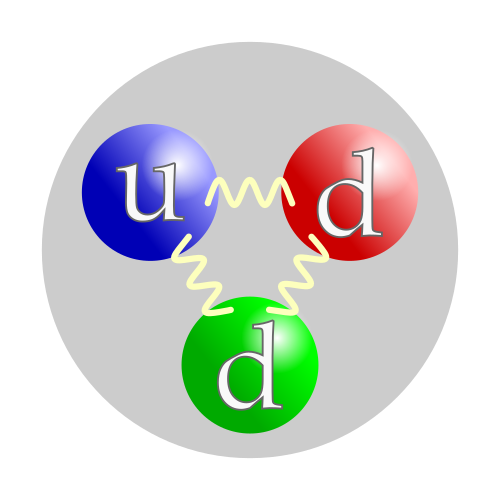Facts for Kids
Neutrons are subatomic particles with no electric charge that reside in an atom's nucleus, contributing to its mass and stability.
Overview
Properties Of Neutrons
Future Research On Neutrons
History Of Neutron Discovery
Safety And Neutron Radiation
Neutron Sources And Detection
Neutrons And Atomic Structure
Neutrons In Nuclear Reactions
Applications Of Neutrons In Science

Inside this Article
University Of Cambridge
Nuclear Fission
Electric Charge
Nuclear Power
Atomic Mass
Technology
Carbon-14
Medicine
Concrete
Did you know?
🔬 Neutrons are neutral particles found in the nucleus of an atom.
⚛️ The mass of a neutron is slightly greater than that of a proton.
🔄 Neutrons play a key role in the stability of atomic nuclei.
🌌 Neutrons are essential in nuclear fission and fusion processes.
🧪 Neutrons have a spin of 1/2, making them fermions.
🏗️ A free neutron has a half-life of approximately 14 minutes and 39 seconds before it decays into a proton, an electron, and an antineutrino.
🌍 Neutrons are used in various applications, including neutron scattering and medical imaging.
💡 Neutrons can penetrate materials more deeply than charged particles, making them useful in research.
⚛️ Neutron stars are incredibly dense remnants of supernova explosions, with densities greater than an atomic nucleus.
🔍 The discovery of the neutron was made by James Chadwick in 1932.
Introduction
️
Properties Of Neutrons
They have no electric charge, which is why they can easily fit with positively charged protons in the nucleus of an atom. Neutrons are slightly heavier than protons and have a mass of about 1.008664 atomic mass units (amu). Each neutron has a mean lifetime of about 14 minutes when outside the nucleus! 🕒
This means if you take a neutron out of an atom, it will eventually decay into a proton and an electron. Neutrons also help keep the atom stable by balancing the positive charge of protons. ⚖
️
Future Research On Neutrons
Future research might help us harness neutrons for cleaner energy sources or advance medical treatments. Some researchers are also exploring how neutrons can help us create super materials for technology. For instance, neutron technology can help build smarter batteries or stronger materials for airplanes! ✈
️ The potential to learn more about neutrons can change the way we live and solve big problems. Who knows what exciting discoveries are yet to come? 🌈
History Of Neutron Discovery
🔬 At that time, scientists knew about protons and electrons, but neutrons were a mystery! Chadwick's experiment involved bombarding beryllium with alpha particles, which led him to find neutrons. His discovery earned him the Nobel Prize in Physics in 1935! 🏆
This was a big breakthrough in understanding atoms, and it opened the door for many new scientific advances.
Safety And Neutron Radiation
️ Neutron radiation can happen when neutrons escape from a nuclear reactor or during certain types of nuclear reactions. This radiation can penetrate matter and damage cells in our bodies. That's why scientists must follow strict safety rules when working with neutrons! 🛡
️ Special shields made from materials like water or concrete are used to protect people from neutron exposure. Always remember, safety first when working with anything that involves radiation! 🛑
Neutron Sources And Detection
One common type is a research reactor that uses nuclear fission to create neutrons. For example, the Oak Ridge National Laboratory in Tennessee is a well-known facility for neutron science! To detect neutrons, scientists use devices called neutron detectors. Some common types of detectors include plastic scintillators and Helium-3 detectors. These tools help researchers measure and study neutrons, making sure they can understand their properties and uses accurately! 📊
Neutrons And Atomic Structure
In fact, 99.9% of the atom's mass comes from the nucleus! The number of neutrons in an atom helps define what element it is. For example, carbon typically has 6 protons and 6 neutrons, while carbon-14 has 6 protons and 8 neutrons. The different numbers of neutrons give rise to different isotopes, which have different properties! 🧬
Neutrons In Nuclear Reactions
This can lead to a process called fission, which is how nuclear power plants create electricity. In fission, a heavy atom (like uranium) splits into smaller atoms, releasing a lot of energy! 🏭
Neutrons can also be used in fusion, where light atoms (like hydrogen) combine to form heavier ones, releasing even more energy. This is what powers the sun and other stars! 🌟
Applications Of Neutrons In Science
They are used in techniques like neutron scattering, which helps scientists study the structure of materials. For instance, scientists can learn about the properties of metals, polymers, and even biological molecules! 🦠
By analyzing how neutrons interact with materials, researchers can understand their behaviors better. Neutrons are also crucial in medicine, as they are used in radiation treatments for cancer. 🏥
This means they help doctors find and destroy cancer cells in our bodies!

